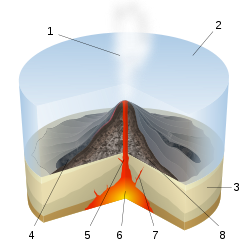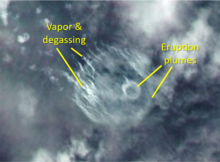
- Water vapor cloud
- Water
- Stratum
- Lava flow
- Magma conduit
- Magma chamber
- Dike
- Pillow lava


Submarine volcanoes are underwater vents or fissures in the Earth's surface from which magma can erupt. Many submarine volcanoes are located near areas of tectonic plate formation, known as mid-ocean ridges. The volcanoes at mid-ocean ridges alone are estimated to account for 75% of the magma output on Earth.[1] Although most submarine volcanoes are located in the depths of seas and oceans, some also exist in shallow water, and these can discharge material into the atmosphere during an eruption. The total number of submarine volcanoes is estimated to be over one million (most are now extinct) of which some 75,000 rise more than 1 kilometre (0.62 miles) above the seabed.[1] Only 119 submarine volcanoes in Earth's oceans and seas are known to have erupted during the last 11,700 years.[2][3]
Hydrothermal vents, sites of abundant biological activity, are commonly found near submarine volcanoes.
- ^ a b Martin R. Speight, Peter A. Henderson, "Marine Ecology: Concepts and Applications", John Wiley & Sons, 2013. ISBN 978-1-4051-2699-1.
- ^ Venzke, E., ed. (2013). "Holocene Volcano List". Global Volcanism Program Volcanoes of the World (version 4.9.1). Smithsonian Institution. Retrieved 18 November 2020.
- ^ Venzke, E., ed. (2013). "How many active volcanoes are there?". Global Volcanism Program Volcanoes of the World (version 4.9.1). Smithsonian Institution. Retrieved 18 November 2020.